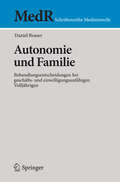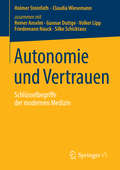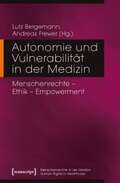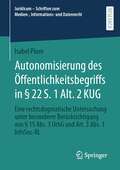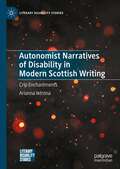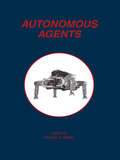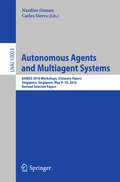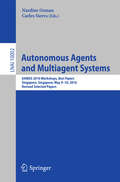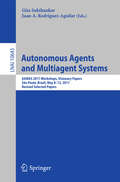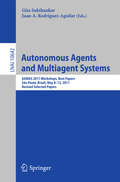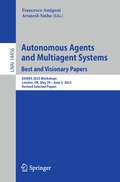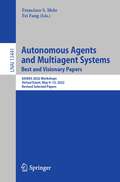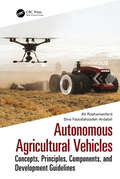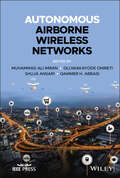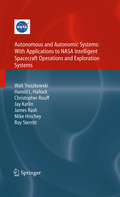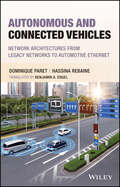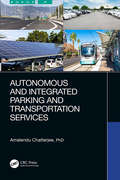- Table View
- List View
Autonomie und Familie: Behandlungsentscheidungen bei geschäfts- und einwilligungsunfähigen Volljährigen (MedR Schriftenreihe Medizinrecht)
by Daniel BrauerBeiträge zur Patientenautonomie gibt es viele. Was bisher aber kaum Beachtung gefunden hat, ist das Verhältnis zwischen Patientenautonomie und der Familie als personellem Nahraum. Das vorliegende Buch schließt diese Lücke, indem es die Bedeutung von Familienangehörigen bei medizinischen Entscheidungssituationen geschäfts- und einwilligungsunfähiger Patienten untersucht. Der Autor bereitet die Thematik systematisch auf, indem er, ausgehend von einer Darstellung eines Autonomiekonzepts und den Grundlagen der medizinischen Behandlung, der Kernfrage nachgeht, wie die Familie in den Entscheidungsfindungsprozess einbezogen wird und warum. Aufbauend auf diesen Erkenntnissen untersucht der Autor, ob aus der Einbeziehung der Familie eine Gefährdung für die Autonomie des Einzelnen folgt. Abschließend wendet sich der Autor der Beteiligung von Familienmitgliedern in den Rechtsordnungen der USA und den sich aus einem Rechtsvergleich ergebenden Handlungsimpulsen für das deutsche Recht zu.
Autonomie und Gerechtigkeit: Das Beispiel der Familientherapie für eine therapeutische Ethik
by Stella Reiter-TheilAutonomie und Kalkulation: Zur Praxis gesellschaftlicher Ökonomisierung im Gesundheits- und Krankenhauswesen (Arbeit und Organisation #1)
by Kaspar MolzbergerDer Strukturwandel im Gesundheitswesen wird häufig als Effizienz- und Qualitätsgewinn zugleich gepriesen. Ein soziologischer Blick indes zeigt: was sich hinter der »Ökonomisierung« der Krankenversorgung verbirgt, ist ein höchst kontroverses Unterfangen. Kaspar Molzberger nimmt in Anlehnung an relationale Sozialtheorien eine Neubestimmung vor. Seine praxissoziologische Studie verdeutlicht, womit die nach professionellen Werten arbeitenden Berufsgruppen in Krankenhäusern zu kämpfen haben, wenn sie den neoliberalen Managementreformen zu entsprechen suchen. Es droht eine »Verkehrung des Gewöhnlichen«: Die Autonomie der Arzt- und Pflegeberufe wird nunmehr als kalkulative behandelt und es ist folglich das Krankenhaus, das mit immer mehr Kranken versorgt werden muss, um zu überleben.
Autonomie und Organisation: Die sozialwissenschaftliche Mystifikation der Verselbständigung von Organisationen (Beiträge zur sozialwissenschaftlichen Forschung #58)
by Friedrich SchönweissAutonomie und Steuerung verselbständigter Behörden: Eine empirische Analyse am Beispiel Deutschlands und Norwegens (Interdisziplinäre Organisations- und Verwaltungsforschung #19)
by Tobias BachEs gibt seit einigen Jahren eine internationale politik- und verwaltungswissenschaftliche Diskussion zu strukturell verselbständigten Behörden außerhalb der Ministerialverwaltung („Agencies“). Ausgangspunkt ist die Beobachtung, dass bei der Ausgestaltung der Steuerungsbeziehungen zwischen Ministerien und Behörden erhebliche Unterschiede festzustellen sind, die sowohl zwischen Behörden eines Landes als auch im internationalen Vergleich bestehen. Tobias Bach untersucht am Beispiel Deutschlands und Norwegens, wie sich nationale Reformverläufe einerseits und organisatorische Merkmale wie Struktur und Aufgabe andererseits auf Steuerungsbeziehungen auswirken. Die empirische Analyse stützt sich auf standardisierte Erhebungen, die im Rahmen des internationalen Forschungsnetzwerkes COBRA („Comparative Public Organization Data Base for Research and Analysis“) durchgeführt wurden.
Autonomie und Vertrauen: Schlüsselbegriffe der modernen Medizin
by Reiner Anselm Gunnar Duttge Volker Lipp Friedemann Nauck Silke SchicktanzDie Selbstbestimmung des Patienten wird in liberalen und individualisierten Gesellschaften zu Recht hochgehalten. Doch die Handlungsfreiheit des Einzelnen in einer hochkomplexen, von wissenschaftlich-technischen Rationalitäten durchstrukturierten Welt wächst nur in dem Maße, wie Personen- und Systemvertrauen ermöglicht wird. Denn mit den Handlungsmöglichkeiten der modernen Medizin wachsen auch Verletzlichkeit und Verunsicherung der Akteure. Die Beiträge dieses Bandes aus den Bereichen Philosophie, Medizinrecht, Theologie, Medizinethik und Medizin untersuchen, inwiefern interpersonelles Vertrauen bzw. Systemvertrauen und Selbstbestimmungspraktiken zusammenhängen. Ein besonderes Augenmerk gilt dabei Institutionen wie dem Krankenhaus sowie Kollektivakteuren wie Familien oder Patientengruppen.
Autonomie und Vulnerabilität in der Medizin: Menschenrechte - Ethik - Empowerment (Menschenrechte in der Medizin / Human Rights in Healthcare #6)
by Lutz Bergemann Andreas FrewerWelche ethische Relevanz haben die menschliche Vulnerabilität und die Menschenrechte für die Gesundheitsversorgung verschiedenster Personengruppen? Die Beiträge dieses interdisziplinären Bandes thematisieren die systematischen Zusammenhänge zwischen der Verletzlichkeit kranker Personen und ihren Menschenrechten und benennen auf dieser Grundlage Probleme in deren medizinischer Versorgung. Aus der Perspektive unterschiedlicher Fachdisziplinen werden zudem Möglichkeiten aufgezeigt, wie im Sinne eines menschenrechtlich legitimierten Empowerments die Situation entlang zentraler Werte wie Würde und Autonomie ganz konkret zu verbessern ist.
Autonomie von Fertigungssegmenten: Analyse zur Gestaltung neuer Fabrikstrukturen
by Andreas LauermannFür die Zukunft der Unternehmen gilt es, Anpassungsfähigkeit und -geschwindigkeit zu einem inhärenten Organisationsmerkmal zu machen. Einen Schlüsselfaktor dieser Gestaltungsaufgabe stellt die Autonomie dar.
Autonomisierung des Öffentlichkeitsbegriffs in § 22 S. 1 Alt. 2 KUG: Eine rechtsdogmatische Untersuchung unter besonderer Berücksichtigung von § 15 Abs. 3 UrhG und Art. 3 Abs. 1 InfoSoc-RL (Juridicum – Schriften zum Medien-, Informations- und Datenrecht)
by Isabel PlumDie Arbeit beschäftigt sich mit dem bildnisrechtlichen Öffentlichkeitsbegriff des § 22 S. 1 Alt. 2 KUG, den der Gesetzgeber trotz des massiven technischen Wandels und der herausragenden Bedeutung von Bildnissen im digitalen Zeitalter seit über 100 Jahren nicht novelliert hat. Vielmehr greift die überwiegende Meinung in der Rechtsprechung und der Literatur im Rahmen des § 22 S. 1 Alt. 2 KUG seit jeher auf das Verständnis des urheberrechtlichen Öffentlichkeitsbegriffs gemäß § 15 Abs. 3 UrhG zurück, der infolge der umfassenden Rechtsprechung des EuGH zu Art. 3 Abs. 1 InfoSoc-RL erhebliche Modifikationen erfahren hat. Die Arbeit widmet sich insoweit der Frage, ob für den bildnisrechtlichen Öffentlichkeitsbegriff tatsächlich der urheberrechtliche Öffentlichkeitsbegriff, die Vorgaben des Art. 3 Abs. 1 InfoSoc-RL sowie die hierzu ergangene Rechtsprechung des EuGH herangezogen werden können. Dabei werden erhebliche Unterschiede zwischen dem bildnisrechtlichen und dem urheberrechtlichen Öffentlichkeitsbegriff konstatiert, die eine Autonomisierung des bildnisrechtlichen Öffentlichkeitsbegriffs gebieten. Die Autorin entwickelt daher einen von § 15 Abs. 3 UrhG und Art. 3 Abs. 1 InfoSoc-RL losgelösten Öffentlichkeitsbegriff, der den bildnisrechtlichen Spezifika Rechnung trägt.
Autonomist Narratives of Disability in Modern Scottish Writing: Crip Enchantments (Literary Disability Studies)
by Arianna IntronaAutonomist Narratives of Disability in Modern Scottish Writing: Crip Enchantments explores the intersection between imaginaries of disability and representations of work, welfare and the nation in twentieth and twenty-first century Scottish literature. Disorienting effects erupt when non-normative bodies and minds clash with the structures of capitalist normalcy. This book brings into conversation Scottish studies, disability studies and Marxist autonomist theory to trace the ways in which these “crip enchantments” are imagined in modern Scottish writing, and the “autonomist” narratives of disability by which they are evoked.
Autonomous Agents
by George BekeyAn agent is a system capable of perceiving the environment, reasoning with the percepts and then acting upon the world. Agents can be purely software systems, in which case their percepts and output `actions' are encoded binary strings. However, agents can also be realized in hardware, and then they are robots. The Artificial Intelligence community frequently views robots as embodied intelligent agents. The First International Conference on Autonomous Agents was held in Santa Monica, California, in February 1997. This conference brought together researchers from around the world with interests in agents, whether implemented purely in software or in hardware. The conference featured such topics as intelligent software agents, agents in virtual environments, agents in the entertainment industry, and robotic agents. Papers on robotic agents were selected for this volume. Autonomous Agents will be of interest to researchers and students in the area of artificial intelligence and robotics.
Autonomous Agents and Multiagent Systems: AAMAS 2016 Workshops, Visionary Papers, Singapore, Singapore, May 9-10, 2016, Revised Selected Papers (Lecture Notes in Computer Science #10003)
by Nardine Osman Carles SierraThis book constitutes the most visionary papers of the AAMAS 2016 Workshops, held in Singapore, Singapore, in May 2016. The 12 revised full papers presented were carefully reviewed and selected from the 12 workshops. They cover specific topics, both theoretical and applied, in the general area of autonomous agents and multiagent systems.
Autonomous Agents and Multiagent Systems: AAMAS 2016 Workshops, Best Papers, Singapore, Singapore, May 9-10, 2016, Revised Selected Papers (Lecture Notes in Computer Science #10002)
by Nardine Osman Carles SierraThis book features a selection of best papers from 11 workshops held at the International Conference on Autonomous Agents and Multiagent Systems, in Singapore in May 2016.The 11 full papers were carefully reviewed and selected for inclusion in this volume. They cover specific topics, both theoretical and applied, in the general area of autonomous agents and multiagent systems.
Autonomous Agents and Multiagent Systems: AAMAS 2017 Workshops, Visionary Papers, São Paulo, Brazil, May 8-12, 2017, Revised Selected Papers (Lecture Notes in Computer Science #10643)
by Gita Sukthankar Juan A. Rodriguez-AguilarThis book compiles the most visionary papers from 10 workshops held at the International Conference on Autonomous Agents and Multiagent Systems, AAMAS 2017, held in Sao Paulo, Brazil, in May 2017. The 15 full papers presented in this volume were carefully reviewed and selected for inclusion in this volume. They deal with novel ideas proposing a change in the way research is currently carried out.
Autonomous Agents and Multiagent Systems: AAMAS 2017 Workshops, Best Papers, São Paulo, Brazil, May 8-12, 2017, Revised Selected Papers (Lecture Notes in Computer Science #10642)
by Gita Sukthankar Juan A. Rodriguez-AguilarThis book features a selection of best papers from 13 workshops held at the International Conference on Autonomous Agents and Multiagent Systems, AAMAS 2017, held in Sao Paulo, Brazil, in May 2017. The 17 full papers presented in this volume were carefully reviewed and selected for inclusion in this volume. They cover specific topics, both theoretical and applied, in the general area of autonomous agents and multiagent systems.
Autonomous Agents and Multiagent Systems. Best and Visionary Papers: AAMAS 2023 Workshops, London, UK, May 29 –June 2, 2023, Revised Selected Papers (Lecture Notes in Computer Science #14456)
by Francesco Amigoni Arunesh SinhaThis book contains visionary and best papers from the workshops held at the International Conference on Autonomous Agents and Multiagent Systems, AAMAS 2023, held in London, UK, during May 29–June 2, 2023.The 12 regular papers, 5 best papers and 7 visionary papers, presented were carefully reviewed and selected from a total of more than 110 contributions to the workshops. They focus on emerging topics and new trends in the area of autonomous agents and multiagent systems and stem from the following workshops:- Workshop on Autonomous Robots and Multirobot Systems (ARMS)- Workshop on Adaptive and Learning Agents (ALA)- Workshop on Interdisciplinary Design of Emotion Sensitive Agents (IDEA)- Workshop on Rebellion and Disobedience in Artificial Intelligence (RaD-AI)- Workshop on Neuro-symbolic AI for Agent and Multi-Agent Systems (NeSyMAS)- Workshop on Multiagent Sequential Decision Making under Uncertainty (MSDM)- Workshop on Citizen-Centric Multi-Agent Systems (C-MAS)
Autonomous Agents and Multiagent Systems. Best and Visionary Papers: AAMAS 2022 Workshops, Virtual Event, May 9–13, 2022, Revised Selected Papers (Lecture Notes in Computer Science #13441)
by Francisco S. Melo Fei FangThis book constitutes thoroughly refereed and revised selected best and visionary papers from the Workshops held at the International Conference on Autonomous Agents and Multiagent Systems AAMAS 2022, which took place online, during May 9–13, 2022.The 5 best papers and 4 visionary papers included in this book stem from the following workshops: - 13th Workshop on Optimization and Learning in Multi-agent Systems (OptLearnMAS);- 23rd Workshop on Multi-Agent Based Simulation (MABS);- 6th Workshop on Agent-Based Modelling of Urban Systems (ABMUS);- 10th Workshop on Engineering Multi-Agent Systems (EMAS);- 1st Workshop on Rebellion and Disobedience in AI (RaD-AI).There was a total of 59 submissions to these workshops.
Autonomous Agricultural Vehicles: Concepts, Principles, Components, and Development Guidelines
by Ali Roshanianfard Sina Faizollahzadeh ArdabiliThis comprehensive guide to agricultural robots is the ideal companion for any student or professional engineer looking to understand and develop autonomous vehicles to use on the modern farm. With world hunger one of the modern era’s most pressing issues, autonomous agricultural vehicles are a key tool in tackling this problem. Smart farming can increase total factory productivity through designing autonomous vehicles based on specific needs, in addition to implementing smart systems into day-to-day operations. This book provides step-by-step guidance, from the theory behind autonomous vehicles, through to the design process and manufacture. Detailing all components of an autonomous agricultural vehicle, from sensors, controlling algorithms, communication and controlling units, the book covers topics such as artificial intelligence and machine learning. It also includes case studies, and a detailed guide to international policymaking in recent years. Suitable for students and professionals alike, this book will be a key companion to those interested in agricultural engineering, autonomous vehicles, robotics, and mechatronics, in mechanical, automotive, and electrical engineering.
Autonomous Agricultural Vehicles: Concepts, Principles, Components, and Development Guidelines
by Ali Roshanianfard Sina Faizollahzadeh ArdabiliThis comprehensive guide to agricultural robots is the ideal companion for any student or professional engineer looking to understand and develop autonomous vehicles to use on the modern farm. With world hunger one of the modern era’s most pressing issues, autonomous agricultural vehicles are a key tool in tackling this problem. Smart farming can increase total factory productivity through designing autonomous vehicles based on specific needs, in addition to implementing smart systems into day-to-day operations. This book provides step-by-step guidance, from the theory behind autonomous vehicles, through to the design process and manufacture. Detailing all components of an autonomous agricultural vehicle, from sensors, controlling algorithms, communication and controlling units, the book covers topics such as artificial intelligence and machine learning. It also includes case studies, and a detailed guide to international policymaking in recent years. Suitable for students and professionals alike, this book will be a key companion to those interested in agricultural engineering, autonomous vehicles, robotics, and mechatronics, in mechanical, automotive, and electrical engineering.
Autonomous Airborne Wireless Networks (Wiley - IEEE)
by Muhammad Ali ImranDiscover what lies beyond the bleeding-edge of autonomous airborne networks with this authoritative new resource Autonomous Airborne Wireless Networks delivers an insightful exploration of recent advances in the theory and practice of using airborne wireless networks to provide emergency communications, coverage and capacity expansion, information dissemination, and more. The distinguished engineers and editors have selected resources that cover the fundamentals of airborne networks, including channel models, recent regulation developments, self-organized networking, AI-enabled flying networks, and notable applications in a variety of industries. The book evaluates advances in the cutting-edge of unmanned aerial vehicle wireless network technology while offering readers new ideas on how airborne wireless networks can support various applications expected of future networks. The rapidly developing field is examined from a fresh perspective, one not just concerned with ideas of control, trajectory optimization, and navigation. Autonomous Airborne Wireless Networks considers several potential use cases for the technology and demonstrates how it can be integrated with concepts from self-organized network technology and artificial intelligence to deliver results in those cases. Readers will also enjoy: A thorough discussion of distributed drone base station positioning for emergency cellular networks using reinforcement learning (AI-enabled trajectory optimization) An exploration of unmanned aerial vehicle-to-wearables (UAV2W) indoor radio propagation channel measurements and modelling An up-to-date treatment of energy minimization in UAV trajectory design for delay tolerant emergency communication Examinations of cache-enabled UAVs, 3D MIMO for airborne networks, and airborne networks for Internet of Things communications Perfect for telecom engineers and industry professionals working on identifying practical and efficient concepts tailored to overcome challenges facing unmanned aerial vehicles providing wireless communications, Autonomous Airborne Wireless Networks also has a place on the bookshelves of stakeholders, regulators, and research agencies working on the latest developments in UAV communications.
Autonomous Airborne Wireless Networks (Wiley - IEEE)
by Muhammad Ali Imran Oluwakayode Onireti Qammer H. AbbasiDiscover what lies beyond the bleeding-edge of autonomous airborne networks with this authoritative new resource Autonomous Airborne Wireless Networks delivers an insightful exploration of recent advances in the theory and practice of using airborne wireless networks to provide emergency communications, coverage and capacity expansion, information dissemination, and more. The distinguished engineers and editors have selected resources that cover the fundamentals of airborne networks, including channel models, recent regulation developments, self-organized networking, AI-enabled flying networks, and notable applications in a variety of industries. The book evaluates advances in the cutting-edge of unmanned aerial vehicle wireless network technology while offering readers new ideas on how airborne wireless networks can support various applications expected of future networks. The rapidly developing field is examined from a fresh perspective, one not just concerned with ideas of control, trajectory optimization, and navigation. Autonomous Airborne Wireless Networks considers several potential use cases for the technology and demonstrates how it can be integrated with concepts from self-organized network technology and artificial intelligence to deliver results in those cases. Readers will also enjoy: A thorough discussion of distributed drone base station positioning for emergency cellular networks using reinforcement learning (AI-enabled trajectory optimization) An exploration of unmanned aerial vehicle-to-wearables (UAV2W) indoor radio propagation channel measurements and modelling An up-to-date treatment of energy minimization in UAV trajectory design for delay tolerant emergency communication Examinations of cache-enabled UAVs, 3D MIMO for airborne networks, and airborne networks for Internet of Things communications Perfect for telecom engineers and industry professionals working on identifying practical and efficient concepts tailored to overcome challenges facing unmanned aerial vehicles providing wireless communications, Autonomous Airborne Wireless Networks also has a place on the bookshelves of stakeholders, regulators, and research agencies working on the latest developments in UAV communications.
Autonomous and Autonomic Systems: With Applications To Nasa Intelligent Spacecraft Operations And Exploration Systems (NASA Monographs in Systems and Software Engineering)
by Walt Truszkowski Harold Hallock Christopher Rouff Jay Karlin James Rash Michael Hinchey Roy SterrittIn the early 1990s, NASA Goddard Space Flight Center started researching and developing autonomous and autonomic ground and spacecraft control systems for future NASA missions. This research started by experimenting with and developing expert systems to automate ground station software and reduce the number of people needed to control a spacecraft. This was followed by research into agent-based technology to develop autonomous ground c- trol and spacecraft. Research into this area has now evolved into using the concepts of autonomic systems to make future space missions self-managing and giving them a high degree of survivability in the harsh environments in which they operate. This book describes much of the results of this research. In addition, it aimstodiscusstheneededsoftwaretomakefutureNASAspacemissionsmore completelyautonomousandautonomic.Thecoreofthesoftwareforthesenew missions has been written for other applications or is being applied gradually in current missions, or is in current development. It is intended that this book should document how NASA missions are becoming more autonomous and autonomic and should point to the way of making future missions highly - tonomous and autonomic. What is not covered is the supporting hardware of these missions or the intricate software that implements orbit and at- tude determination, on-board resource allocation, or planning and scheduling (though we refer to these technologies and give references for the interested reader).
Autonomous and Connected Vehicles: Network Architectures from Legacy Networks to Automotive Ethernet
by Dominique Paret Hassina RebaineAUTONOMOUS AND CONNECTED VEHICLES Discover the latest developments in autonomous vehicles and what the future holds for this exciting technology In Autonomous and Connected Vehicles, networking experts Dominique Paret and Hassina Rebaine deliver a robust exploration of the major technological changes taking place in the field, and describe the different levels of autonomy possible with current technologies and the legal and regulatory contexts in which new autonomous vehicles will circulate. The book also includes discussions of the sensors, including infrared, ultrasound, cameras, lidar, and radar, used by modern autonomous vehicles. Readers will enjoy the intuitive descriptions of Advanced Driver Assistance Systems (ADAS), network architectures (CAN-FD, FlexRay, and Backbone Ethernet), and software that power current and future autonomous vehicles. The authors also discuss how ADAS can be fused with data flowing over newer and faster network architectures and artificial intelligence to create greater levels of autonomy. The book also includes: A thorough introduction to the buzz and hype surrounding autonomous and connected vehicles, including a brief history of the autonomous vehicle Comprehensive explorations of common issues affecting autonomous and connected vehicles, including regulatory guidelines, legislation, relevant norms and standards, and insurance issues Practical discussions of autonomous vehicle sensors, from DAS to ADAS and HADAS, and VA L3 to L5 In-depth examinations of networks and architecture, including discussions of data fusion, artificial intelligence, and hardware architecture in vehicles Perfect for graduate and undergraduate students in programs dealing with the intersection of wireless communication technologies and vehicles, Autonomous and Connected Vehicles is also a must-read reference for industry professionals and researchers seeking a one-stop reference for the latest developments in vehicle communications technology.
Autonomous and Connected Vehicles: Network Architectures from Legacy Networks to Automotive Ethernet
by Dominique Paret Hassina RebaineAUTONOMOUS AND CONNECTED VEHICLES Discover the latest developments in autonomous vehicles and what the future holds for this exciting technology In Autonomous and Connected Vehicles, networking experts Dominique Paret and Hassina Rebaine deliver a robust exploration of the major technological changes taking place in the field, and describe the different levels of autonomy possible with current technologies and the legal and regulatory contexts in which new autonomous vehicles will circulate. The book also includes discussions of the sensors, including infrared, ultrasound, cameras, lidar, and radar, used by modern autonomous vehicles. Readers will enjoy the intuitive descriptions of Advanced Driver Assistance Systems (ADAS), network architectures (CAN-FD, FlexRay, and Backbone Ethernet), and software that power current and future autonomous vehicles. The authors also discuss how ADAS can be fused with data flowing over newer and faster network architectures and artificial intelligence to create greater levels of autonomy. The book also includes: A thorough introduction to the buzz and hype surrounding autonomous and connected vehicles, including a brief history of the autonomous vehicle Comprehensive explorations of common issues affecting autonomous and connected vehicles, including regulatory guidelines, legislation, relevant norms and standards, and insurance issues Practical discussions of autonomous vehicle sensors, from DAS to ADAS and HADAS, and VA L3 to L5 In-depth examinations of networks and architecture, including discussions of data fusion, artificial intelligence, and hardware architecture in vehicles Perfect for graduate and undergraduate students in programs dealing with the intersection of wireless communication technologies and vehicles, Autonomous and Connected Vehicles is also a must-read reference for industry professionals and researchers seeking a one-stop reference for the latest developments in vehicle communications technology.
Autonomous and Integrated Parking and Transportation Services
by Amalendu ChatterjeeIn this book, the author outlines a Robust Web Parking, Truck and Transportation Portal (RWPTTP) for integrating parking and transportation services – a revolutionary approach in contrast to incremental change for managing traffic congestion. Autonomous vehicle technology, artificial intelligence, internet of things (IOT), and other interconnected hardware and software tools will assist autonomous parking and transportation services and provide next-century infrastructure for consolidated transportation customer services. The book highlights currently available autonomous parking and transportation technologies, and the development of an integrated and intelligent transportation service/system (IITS) platform, with specific use of technologies to reconfigure the transportation industry. The author also suggests many regulatory and policy changes to simplify data collection, traffic operation, introduction of a duplicate transportation system using light rail (LRs) and high speed rail (SPRs), and redistribution of parking spaces along such routes, using renewable energy.
